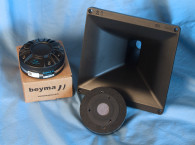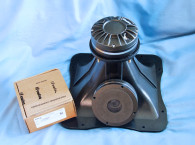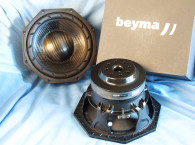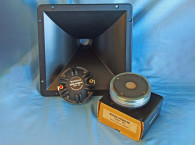The driver Beyma sent Voice Coil this month is a new transducer from its extensive line-up of 33 compression drivers. The 1” throat uber-compact CD1ND compression driver accompanied by the Beyma 90° x 40° TD-194 constant directivity horn (Photo 1). Designed for use with 1” throat horns, the ultra-compact footprint (64mm diameter) CD1ND is presented as a compression driver to use where a compact “high-quality” cost-effective compression driver is required for compact systems (e.g., in studio monitors or stage monitors). The Beyma CD1ND compression driver has a 1” (25.4mm) throat diameter driven by a 1” (25.1mm) diameter edge-wound voice coil wound with aluminum wire on a non-conducting former.

This assembly drives the field-replaceable polyimide diaphragm. Other features include a lightweight computer FEA-optimized neodymium ring magnet motor structure (the net weight is only 0.9 lbs.), a 20W AES power handling of 20W (above 2kHz, 40W program), a 2kHz recommended crossover frequency (with a minimum 12dB/octave high-pass network), a 1W/1m 110dB sensitivity, plus standard solderable terminals.
Along with the Beyma CD1ND, I used the Beyma 1” throat cast aluminum TD-194 90° × 40° constant directivity horn with a 1200Hz cut-off frequency. This horn is also conveniently marked so the user will get the orientation correct (Photo 2).

Testing began as usual by using the LinearX LMS analyzer to produce the 300-point stepped sine wave impedance plot shown in Figure 1, with the solid black curve representing the CD1ND mounted on the TD-194 horn and the dashed blue curve representing the compression driver without the horn. With nominal 8Ω impedance, the TD-194 horn has a 4.68Ω Re and minimum impedance of 5.31Ω at 4.99kHz.

For the first group of SPL measurements, I free-air mounted the Beyma CD1ND/TD-194 combination without an enclosure and measured both the horizontal on- and off-axis at 2.0V/0.5m (normalized to 2.83V/1m) from 0° on-axis to 60° off-axis using the Loudsoft FINE R+D analyzer and the GRAS 46BE microphone (supplied courtesy of Loudsoft and GRAS Sound & Vibration). Figure 2 displays the on-axis frequency response of the compression driver/horn, which shows a smooth ±1.5dB response from 2.1kHz to 10kHz (measured on the constant directivity “angle”). Figure 3 depicts the 0° to 60° on- and off-axis response in the horizontal plane. Figure 4 illustrates the normalized horizontal plane response. Figure 5 shows the 180° horizontal polar plot (in 10° increments with 1/3 octave smoothing applied), using the CLIO Pocket analyzer and accompanying microphone (courtesy of Audiomatica SRL).




For the vertical plane, Figure 6 illustrates the 0° to 60° on- and off-axis response. Figure 7 depicts the normalized vertical plane response. Figure 8 shows the CLIO Pocket analyzer-generated 180° vertical polar plot (in 10° increments with 1/3 octave smoothing applied).



The last of the SPL measurements, Figure 9 depicts the two-sample SPL comparison, showing the two Beyma CD1ND/TD-194 compression driver samples to be closely matched within 0.5dB to 1dB or less throughout the driver’s operating range.

For the remaining sequence of tests, I again set up the Listen, Inc. AudioConnect analyzer and 1/4” SCM microphone (provided to Voice Coil courtesy of Listen Inc.) to measure distortion and generate time-frequency plots. For the distortion measurement, I again mounted the Beyma CD1ND/TD-194 combination in free-air in the same manner as was used for the frequency response measurements. Next, I set the SPL to 104dB at 1m (2.20V), determined by using a pink noise stimulus generator and internal SLM in the SoundCheck 18 software. Then, I measured the distortion with the Listen microphone placed 10cm from the mouth of the horn. This produced the distortion curves shown in Figure 10, exhibiting very low third-harmonic content.

After completing this test protocol, I then set up SoundCheck 18 to generate a 2.83V/1m impulse response curve for this driver/horn combination and imported the data into Listen’s SoundMap Time/Frequency software. Figure 11 shows the resulting cumulative spectral decay (CSD) waterfall plot. Figure 12 shows the Short Time Fourier Transform (STFT) plot.


Taking into consideration all the objective measurement data presented here, the ultra-compact Beyma CD1ND compression driver is clearly a well-engineered 1” compression driver, exhibiting good performance, outstanding build quality, and featuring an ultra-lightweight assembly, demonstrating the excellent transducer engineering I always observe when characterizing Beyma products. For more information about Beyma OEM pro sound products, visit www.beyma.com. VC
This article was originally published in Voice Coil, April 2022







